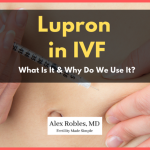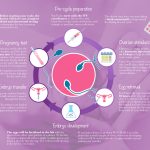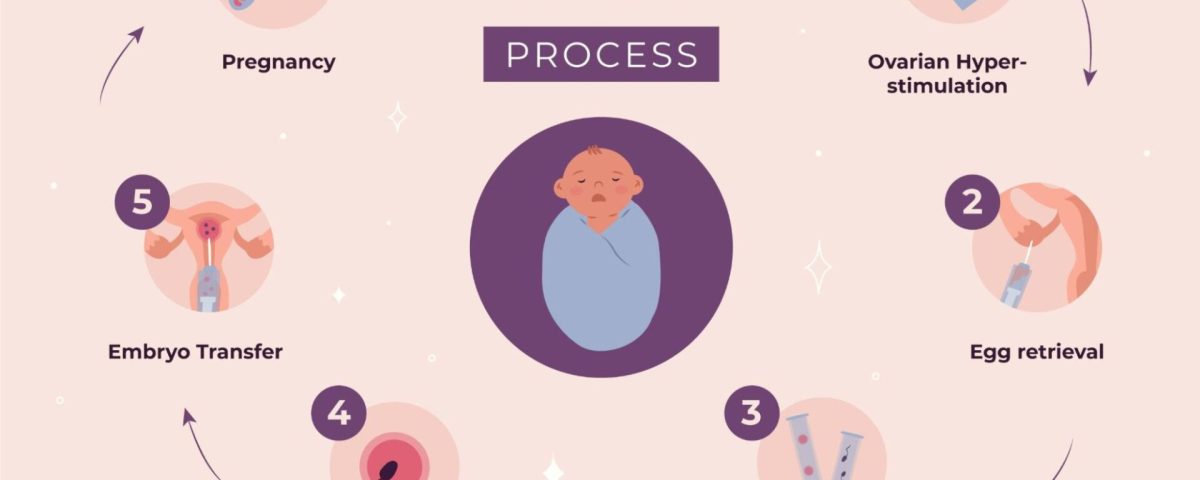
What Is Lupron Used for in IVF?
April 25, 2025
What Happens After Egg Transfer in IVF: Your Complete Guide to the Journey Ahead
April 25, 2025What Is IVF? Understanding the Meaning and Magic Behind In Vitro Fertilization
In vitro fertilization, or IVF, is a term you might have heard tossed around in conversations about starting a family, especially when things don’t go as planned. It’s a process that’s helped millions of people welcome babies into their lives, but it’s also surrounded by questions, curiosity, and even a bit of mystery. If you’re wondering what IVF really means—not just the textbook definition, but what it truly involves for those who go through it—you’re in the right place. This isn’t just about science; it’s about hope, resilience, and the incredible journey to parenthood.
IVF stands for “in vitro fertilization,” which translates from Latin to “fertilization in glass.” Picture a tiny miracle happening outside the body, in a lab dish, before it finds its way to where it belongs. It’s a blend of cutting-edge technology and human determination, designed for people facing challenges with natural conception. Whether you’re exploring this for yourself, supporting a loved one, or just curious, let’s dive into what IVF means, how it works, and why it’s such a game-changer.
The Basics: What Does IVF Mean in Simple Terms?
At its core, IVF is a way to help people have a baby when getting pregnant the usual way isn’t working. It involves taking an egg from a woman, combining it with sperm in a lab, and then placing the resulting embryo back into the womb to grow. Think of it like giving nature a little nudge with some high-tech help.
The process starts with boosting the ovaries to produce more eggs than usual, collecting those eggs, and then mixing them with sperm in a controlled environment. Once an embryo forms and grows for a few days, it’s transferred to the uterus, where it hopefully implants and develops into a pregnancy. It’s not a one-size-fits-all solution, but it’s opened doors for people dealing with infertility, same-sex couples, and even single parents-to-be.
Why does this matter? About one in eight couples in the U.S. struggle with infertility, according to the CDC. That’s millions of people who might feel stuck—IVF offers them a chance to keep moving forward. It’s not a guarantee, but it’s a powerful option that’s changed the game since the first IVF baby, Louise Brown, was born in 1978.
How IVF Works: A Step-by-Step Journey
IVF isn’t a single event—it’s a series of steps that can take weeks or even months. Each phase is carefully timed and tailored to the individual. Here’s what the journey looks like, broken down into bite-sized pieces so you can picture it clearly.
Step 1: Boosting Egg Production
The process kicks off with medications that stimulate the ovaries to produce multiple eggs. Normally, a woman releases one egg per month, but IVF needs more to increase the odds of success. These drugs, often injections, might sound intense, but they’re a key part of the plan. Doctors monitor this closely with ultrasounds and blood tests to make sure everything’s on track.
Step 2: Collecting the Eggs
Once the eggs are ready—usually after about 10-14 days of stimulation—they’re retrieved in a minor procedure. A thin needle, guided by ultrasound, gently pulls the eggs from the ovaries. You’re usually under light sedation, so it’s not as scary as it might sound. This step takes about 20-30 minutes, and you’re back home the same day.
Step 3: Fertilizing the Eggs
Now comes the “in vitro” part. In a lab, the eggs meet the sperm—either by mixing them together or, in some cases, injecting a single sperm directly into an egg (a technique called ICSI). Scientists watch as fertilization happens, and over the next few days, the embryos start to grow. It’s like a tiny science experiment with huge stakes.
Step 4: Growing Healthy Embryos
For 3-5 days, the embryos develop in a special incubator. Lab experts check their progress, looking for the strongest ones. Sometimes, genetic testing is done here to screen for issues like chromosomal abnormalities—something not every article dives into, but it’s a growing part of IVF that can make a big difference.
Step 5: Transferring the Embryo
The best embryo (or sometimes two) is placed into the uterus using a thin tube. It’s quick, painless, and doesn’t usually require anesthesia. Then, you wait—about two weeks—to take a pregnancy test and see if it worked. This waiting period? It’s a rollercoaster of hope and nerves.
Step 6: The Outcome
If the embryo implants, congratulations—you’re pregnant! If not, it’s tough, but many people try again. Success rates vary—about 40% for women under 35, dropping as age rises, per the American Society for Reproductive Medicine (ASRM). It’s not a one-shot deal for everyone, and that’s okay.
Who Might Need IVF? More Than You Think
IVF isn’t just for one type of person—it’s a lifeline for all kinds of situations. Here are some reasons people turn to it:
- Blocked Fallopian Tubes: If the tubes where eggs travel are damaged, natural conception gets tricky.
- Low Sperm Count: When sperm numbers or quality are off, IVF can step in with ICSI to make fertilization happen.
- Unexplained Infertility: Sometimes, doctors can’t pinpoint why pregnancy isn’t occurring—IVF can bypass the mystery.
- Age-Related Challenges: As women get older, egg quality drops. IVF can use younger eggs (from a donor, if needed) to boost chances.
- LGBTQ+ Families: Same-sex couples or single individuals often use IVF with donor eggs, sperm, or surrogates to build their families.
What’s less talked about? IVF’s role in preserving fertility. People facing cancer treatments, for example, might freeze eggs or embryos beforehand. It’s a proactive move that’s gaining traction but doesn’t always make the headlines.
The Emotional Side: What IVF Feels Like
IVF isn’t just physical—it’s an emotional marathon. The injections, the waiting, the uncertainty—it can feel like you’re riding a wave of highs and lows. One day, you’re hopeful; the next, you’re anxious. Studies from the Journal of Psychosomatic Obstetrics & Gynecology show that about 25% of women going through IVF experience significant stress or depression. That’s not to scare you—it’s to say you’re not alone if it feels heavy.
Here’s a quick checklist to cope:
✔️ Talk It Out: Share with a partner, friend, or therapist. Bottling it up makes it harder.
✔️ Set Small Goals: Focus on one step at a time, not the whole journey.
✔️ Rest Up: Sleep and self-care keep you grounded.
❌ Don’t Compare: Every IVF story is unique—scrolling social media for “success stories” can backfire.
One couple I heard about described it like planting a garden: “You water it, you wait, and you pray it grows—but sometimes you have to start over.” That mix of effort and surrender? It’s the heart of IVF.
The Science Behind IVF: What’s New in 2025?
IVF isn’t stuck in the past—it’s evolving fast. By April 2025, some exciting updates are making waves. A study from the National Institutes of Health (NIH) last year showed that AI is now helping pick the healthiest embryos with up to 85% accuracy—way better than the human eye alone. This could mean higher success rates and fewer cycles.
Another breakthrough? Time-lapse imaging. Labs use cameras to watch embryos grow without disturbing them, spotting tiny details that predict success. It’s like a baby monitor for the earliest stages of life. And don’t miss this: mitochondrial replacement therapy, where scientists tweak an egg’s energy supply, is showing promise for older women or those with certain genetic risks. It’s still experimental, but it’s a glimpse into IVF’s future.
These advances aren’t in every clinic yet, but they’re shifting the landscape. If you’re considering IVF, ask your doctor about what’s cutting-edge—it might make a difference.
Costs and Access: The Real Talk
IVF isn’t cheap. In the U.S., one cycle averages $12,000-$15,000, not counting meds (another $3,000-$5,000), per the ASRM. Insurance coverage varies wildly—some states mandate it, others don’t. That’s a hurdle not every article tackles head-on, but it’s huge for real people.
Here’s a breakdown:
| Expense | Average Cost | What It Covers |
|---|---|---|
| Egg Stimulation | $3,000-$5,000 | Medications to boost egg production |
| Egg Retrieval | $5,000-$7,000 | Procedure and lab work |
| Embryo Transfer | $3,000-$5,000 | Placing embryo in uterus |
| Genetic Testing | $2,000-$4,000 | Optional screening (if used) |
Tips to manage costs:
✔️ Look for Grants: Groups like BabyQuest offer financial help.
✔️ Check Insurance: Even partial coverage can cut the bill.
✔️ Consider Clinics Abroad: Places like Spain or Mexico offer quality IVF for less—sometimes half the U.S. price.
❌ Don’t Skimp on Research: Cheaper isn’t always better; vet the clinic’s success rates.
A unique angle? Some employers, like Starbucks or Google, now offer IVF benefits. It’s not universal, but it’s a trend worth watching in 2025 as more companies prioritize family-building perks.
Success Rates: What to Expect
Success isn’t guaranteed, and that’s a tough pill to swallow. The CDC tracks this closely: for women under 35, about 40% of IVF cycles lead to a live birth. Over 40? It drops to 10-15%. Age matters—a lot—because egg quality declines over time.
But here’s a twist: lifestyle tweaks can nudge those odds up. A 2024 study in Fertility and Sterility found that women who ate a Mediterranean diet (think fish, veggies, olive oil) had a 20% higher success rate than those who didn’t. Exercise, sleep, and cutting stress also play roles. It’s not a magic fix, but it’s empowering to know you can influence the outcome.
Quick Quiz: What’s Your IVF Readiness?
Answer these to see where you stand:
- Are you under 35? (Yes = better odds)
- Do you eat a balanced diet? (Yes = bonus points)
- Can you manage stress well? (Yes = big help)
More “yes” answers? You’re in a strong spot to start.
Risks and Realities: What No One Tells You
IVF is safe overall, but it’s not risk-free. The meds can cause bloating, mood swings, or, rarely, ovarian hyperstimulation syndrome (OHSS), where ovaries overreact—about 1-2% of cases, per the Mayo Clinic. Multiple births (twins or more) are another risk if more than one embryo is transferred, which can mean preterm delivery.
Less discussed? The mental toll of “leftover” embryos. If you end up with extras, you face choices: freeze them, donate them, or discard them. It’s a decision that hits some people harder than expected. One woman shared, “I couldn’t stop thinking about those little possibilities sitting in a freezer.” It’s a side of IVF that deserves more airtime.
Practical advice:
✔️ Ask About Single Transfers: One embryo cuts multiple-birth risks.
✔️ Plan for Embryos: Decide early what feels right for you.
❌ Don’t Ignore Symptoms: Swelling or pain? Call your doctor fast.
IVF Myths: Busting the Big Ones
Misinformation floats around IVF like confetti. Let’s clear the air:
- Myth: IVF babies are “unnatural.”
Truth: They’re as natural as any baby—just conceived differently. Studies show no higher rates of health issues compared to naturally conceived kids. - Myth: IVF is only for women.
Truth: Men’s sperm health is half the equation. ICSI proves it’s a team effort. - Myth: It works every time.
Truth: It’s a process, not a promise. Multiple cycles are common.
A fresh take? Some worry IVF “plays God.” But flip that: it’s humans using tools to solve a problem, like fixing a broken leg with surgery. It’s less about control and more about possibility.
The Future of IVF: Where Are We Headed?
By 2025, IVF is pushing boundaries. Beyond AI and imaging, gene editing (like CRISPR) is creeping into the conversation. It’s not mainstream yet, but it could one day prevent genetic diseases before birth. Ethical debates are heating up—should we tweak DNA?—but the potential is wild.
Another trend: accessibility. The Biden administration’s 2025 push to lower IVF costs (via the Federal Register) aims to ease financial barriers. If it sticks, more people could get a shot at parenthood. Meanwhile, at-home fertility tests are booming, letting you check egg or sperm health before diving in. It’s DIY meets high-tech.
Poll Time: What’s Your Take?
What excites you most about IVF’s future?
A) Lower costs
B) Better tech
C) More options
Drop your pick in your mind—it’s fun to think about!
Real Stories: IVF in Action
Numbers and science are great, but stories hit home. Take Sarah, 38, who tried IVF after years of unexplained infertility. “The first round failed, and I was crushed,” she said. “But the second time, I saw two lines on the test. Now I’ve got a toddler running around.” Her tip? “Trust your gut—and your doctor.”
Then there’s Mark and James, a couple who used IVF with a surrogate. “We didn’t know where to start, but the clinic walked us through it,” Mark shared. “Holding our son was worth every step.” Their journey highlights IVF’s reach beyond traditional paths.
These aren’t just anecdotes—they’re proof IVF adapts to real lives, not just lab stats.
Your Next Steps: Starting the IVF Conversation
Thinking about IVF? It’s not a solo mission. Here’s how to kick things off:
- Talk to Your Doctor: A fertility specialist can run tests (like hormone levels or sperm analysis) to see if IVF fits.
- Research Clinics: Look for high success rates and good reviews—check the CDC’s ART database.
- Budget It Out: Map your finances and explore aid options.
- Build a Support Crew: Friends, family, or a counselor can keep you steady.
Not ready? That’s fine. Even learning about it puts you ahead. Knowledge is power, especially here.
The Bigger Picture: Why IVF Matters
IVF isn’t just about babies—it’s about choice. It’s given people control over a part of life that can feel unfair. In 2023 alone, over 91,000 babies were born via IVF in the U.S., per the CDC. That’s a small city of new lives, each with a story that started in a dish.
What’s overlooked? Its ripple effect. Grandparents get grandkids. Communities grow. And science keeps learning—every cycle teaches us more about human beginnings. It’s not perfect, but it’s profound.
Final Checklist: Are You IVF-Curious?
✔️ Struggling to conceive?
✔️ Open to tech helping nature?
✔️ Ready for a journey, not a sprint?
If you’re nodding, IVF might be your next chapter.
So, what is IVF? It’s hope in a lab coat. It’s a chance when the odds feel stacked. And in 2025, it’s more accessible, advanced, and personal than ever. Whether it’s your path or not, understanding it lights up a corner of the world that’s all about new beginnings.




